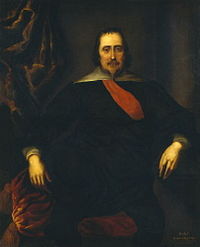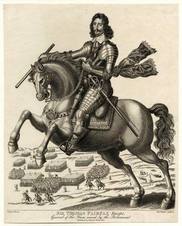The battle raged for most of the day, but by the end of it Henry Grey, Earl of Stamford, had lost half of his forces enabling the Cornish Royalist army to march across the border from Cornwall to Devon. It was a Royalist victory, and a quite remarkable one considering the three thousand Royalist troops, under Sir Ralph Hopton, faced Grey's Parliamentarian army that numbered over five and a half thousand.
|
The Cornish town of Stratton, that lies close to the boarder with Devon, was a manor owned by my ancestors in the early 12th century, its history, and theirs is quite fascinating. Stratton was the head of its hundred (a division of the county for judicial purposes) which is a good indicator of its importance in the north of Cornwall. It had a thriving agricultural and leather trade. By the 17th century there was little to show that my ancestors ever lived there, however on the 16th May 1643, a civil war battle, the Battle of Stratton, took place at the base of Stamford Hill, less than a mile north of the family's castle. The battle raged for most of the day, but by the end of it Henry Grey, Earl of Stamford, had lost half of his forces enabling the Cornish Royalist army to march across the border from Cornwall to Devon. It was a Royalist victory, and a quite remarkable one considering the three thousand Royalist troops, under Sir Ralph Hopton, faced Grey's Parliamentarian army that numbered over five and a half thousand. By July, Hopton had lead his forces in two more battles, one at Crediton and one at Landsdowne, where Hopton was injured. A year later he successfully defended Devizes from an attack by William Waller's forces and two years after that he had taken up a defensive position in the Devon town ofTorrington, a battle that marked the end of Royalist resistance in the West Country. Henry Grey's failure at Stratton and the surrender of the City of Exeter after a three month siege effectively ended his career as a Parliamentary commander.
0 Comments
16th May 1643The Cornish town of Stratton, that lies close to the boarder with Devon, was a manor owned by my ancestors in the early 12th century, its history, and theirs is quite fascinating. Stratton was the head of its hundred (a division of the county for judicial purposes) and was an important stannary town in the north of Cornwall. It had a thriving agricultural and leather trade. By the 17th century there was little to show that my ancestors ever lived there, however on the 16th May 1643, a civil war battle, the Battle of Stratton, took place at the base of Stamford Hill, less than a mile north of the family's castle. The battle raged for most of the day, but by the end of it Henry Grey, Earl of Stamford, had lost half of his forces enabling the Cornish Royalist army to march across the border from Cornwall to Devon. It was a Royalist victory, and a quite remarkable one considering the three thousand Royalist troops, under Sir Ralph Hopton, faced Grey's Parliamentarian army that numbered over five and a half thousand. By July, Hopton had lead his forces in two more battles, one at Crediton and one at Landsdowne, where Hopton was injured. A year later he successfully defended Devizes from an attack by William Waller's forces and two years after that he had taken up a defensive position in the Devon town of Torrington, a battle that marked the end of Royalist resistance in the West Country.
Henry Grey's failure at Stratton and the surrender of the city of Exeter after a three month siege effectively ended his career as a Parliamentary commander. On the 19th August in 1685, trials began in Winchester that have come to be known as the Bloody Assizes. On trial were over one thousand men - rebels who took part in the Monmouth Rebellion. Nearly all would die the horrible death by hanging, disembowelling and quartering, others were transported to the West Indies.
The judges were Sir Henry Pollexfen, Sir Creswell Levinz, Sir Francis Wythens, Sir Robert Wright and Sir William Montague and at their head, Lord Chief Justice George Jeffreys. Judge Jeffreys was a hard, bitter and vengeful man, who Gilbert Burnet in his History of My Own Time writes of Jeffrey. "His behaviour was beyond anything that was ever heard of in a civilized nation. He was perpetually either drunk or in a rage, liker a fury that the zeal of a judge. He required the prisoners to plead guilty. And in that case he gave them some hope of favour, if they gave him no trouble; otherwise he told them, he would execute the letter of the law upon them in its utmost severity." Whether you were old and female made no difference as Lady Alice Lisle would find out to her cost. meanderingthroughtime.weebly.com/history-blog/category/battle-of-sedgemoor In what could be called a bit of a coup, Sir Ralph Hopton replaced Sir Richard Grenville at the head of the West Country royalist forces when Grenville refused to serve under Hopton and resigned his commission. Beginning in the spring of 1643, Hopton's five Cornish regiments had defeated the Parliamentarian forces on Cornwall's border and were soon marching through neighboring Devon. By July, Hopton had led his forces in two battles, one at Crediton and at Landsdowne, where Hopton was injured. In 1644 Hopton, successfully defended Devizes from an attack by William Waller's forces and two years later he had taken up a defensive position in the Devon town of Torrington. It was on the 16th February 1646, that Ralph Hopton faced the army of Thomas Fairfax in what is known as the Battle of Torrington. A popular general, Thomas Fairfax, who was nearly twenty years younger than Hopton, had lead his troops to victory at the Battle of Nantwich in 1644, Naseby in 1645 and Colchester in 1648 and at thirty-two he had been appointed Commander in Chief of the New Model Army. The 16th February 1646 turned out to be wet and cold, the combined forces of about seventeen thousand men fought on the narrow streets. No doubt the inhabitants of Torrington thought the bloodshed would never end, but end it did when gunpowder, that was stored in the parish church, was ignited by a stray spark. The explosion killed many from both sides effectively ending the battle. Ralph Hopton ordered to retreat, he and the remaining royalist army escaped back into Cornwall where he finally surrendered to Fairfax in Truro on 14 March.
The Battle of Torrington marked the end of Royalist resistance in the West Country. It was on the 4th January in 1642, that King Charles I, accompanied by a number of soldiers, arrived at Westminster with the intent to arrest John Pym, John Hampden, Denzil Holles, Arthur Haselrig and William Strode, five Members of his Parliament on the grounds that they had encouraged the Scots to invade England.
William Strode was the son of William Strode of Plympton in Devon, he married into the Meavy family of Meavy, eventually owning their estates in Devon. The painting below, by Charles West Cope, shows the attempted arrest, it can be seen in the Houses of Parliament. One of the most important leaders of the English Civil War, Thomas Fairfax, was born this day in 1612. Fairfax, being tall, dark and I suspect handsome was known by his nick name Black Tom. He led his troops to victory at the of Battle of Nantwich in 1644, Naseby in 1645 and Colchester in 1648. At 32 he was appointed Commander in Chief of the New Model Army.
Fairfax was a popular general, but could be ruthless, he approved the executions of Royalist leaders George Lisle and Charles Lucas and the following year he ordered the execution of mutineers, he was a man of action not a man of words often finding himself out maneuvered in Parliament. He sort to resign his post as Commander in Chief, but was persuaded not to, eventually though he would find himself overshadowed by Oliver Cromwell. It must not be forgotten that Fairfax was instrumental in the defeat of the Royalist party, but he also played his part in the restoration of the monarchy, it was one of Fairfax's horses that England's new king, Charles II rode at his coronation. King Charles I said of Thomas Fairfax "The general is a man of great honour." Just two weeks after the Battle of Sedgemoor, Lady Alice Lisle, whose husband had played an important part in the execution of Charles I, gave shelter to Richard Nelthorpe and John Hicks, two supporters of the Duke of Monmouth at her home of Moyles Court in Hampshire. The following day Nelthorpe and Hicks were discovered and arrested as was Alice Lisle. Alice was charged with harbouring traitors and sentenced to death by Judge Jeffrey's, the notorious 'Hanging Judge.' Jeffrey, who has gone down in history as a hard, bitter and vengeful man, replied when he was questioned about Alice's sentence, that he would have found her guilty "even if she had been my own mother" A hard man indeed. Alice was sentenced to be burnt at the stake, however because of her rank James II ordered it changed to beheading, she was executed on the 2nd September 1685, she was 78 years old.
One of the most important leaders of the English Civil War, Thomas Fairfax, was born this day in 1612. Fairfax, being tall, dark and I suspect handsome was known by his nick name Black Tom. He lead his troops to victory at the battle of Battle of Nantwich in 1644, Naseby in 1645 and Colchester in 1648. At 32 he was appointed Commander in Chief of the New Model Army. Fairfax was a popular general, but could be ruthless, he approved the executions of Royalist leaders George Lisle and Charles Lucas and the following year he ordered the execution of mutineers. However, he was a man of action not a man of words, often finding himself out maneuvered in Parliament he sort to resign his post as Commander in Chief, but was persuaded not to, but he would eventually find himself overshadowed by Oliver Cromwell. It must not be forgotten that Fairfax was instrumental in the defeat of the Royalist party, but he also played his part in the restoration of the monarchy, it was one of Fairfax's horses that England's new king, Charles II rode at his coronation. King Charles I said of Thomas Fairfax "The general is a man of great honour."
|
Archives
February 2024
Categories
All
After ten years in the workplace I became a mother to three very beautiful daughters, I was fortunate enough to have been able to stay at home and spend my time with them as they grew into the young women they are now. I am still in the position of being able to be at home and pursue all the interests I have previously mentioned. We live in a beautiful Victorian spa town with wooded walks for the dog, lovely shops and a host of lovely people, what more could I ask for.
All works © Andrea Povey 2014. Please do not reproduce without the expressed written consent of Andrea Povey. |





















 RSS Feed
RSS Feed
